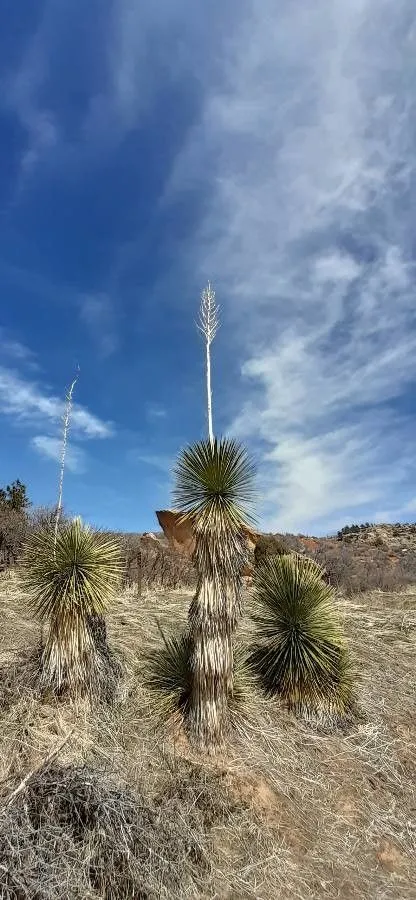
Author: (Engelm.) Engelm.
Bibliography: Bot. Gaz. 7: 17 (1882)
Year: 1882
Status: accepted
Rank: species
Genus: Yucca
Vegetable: False
Observations: Arizona to W. Texas and N. Mexico
The Soaptree Yucca, scientifically known as Yucca elata, is a striking and resilient plant native to the arid regions of Arizona, western Texas, and northern Mexico. Belonging to the Asparagaceae family, this species was first described in the botanical literature in 1882, reflecting its long-standing recognition and importance among botanists and plant enthusiasts.
Characterized by its tall, slender trunk which can reach heights of up to 15 feet, the Soaptree Yucca is adorned with a dense crown of narrow, pointed leaves that radiate outwards like a splendid green halo. These sword-like leaves, typically a foot or more in length, are edged with fine, curling fibers that add to the plant’s distinctive appearance.
The yucca thrives in sandy soils, often forming picturesque landscapes within the desert where it serves as an important ecological component. Its roots possess unique saponins, natural detergents that have historically been utilized by indigenous peoples for soap-making, thus bestowing the plant with its common name.
In late spring to early summer, the Soaptree Yucca produces a dramatic inflorescence. A towering stalk emerges from the center of the rosette, adorned with a multitude of creamy-white flowers, each bell-shaped and subtly fragrant. These blooms not only add to the yucca’s ornamental value but also provide nectar for native pollinators, including yucca moths, which play a crucial role in the plant’s reproduction.
As a hardy species adapted to survive in extreme conditions, Yucca elata is an excellent choice for xeriscaping and water-wise gardens. It requires minimal maintenance once established, making it a versatile and sustainable option for landscaping in arid climates. The Soaptree Yucca’s enduring beauty and historical significance to native cultures underscore its valuable role in the ecosystems where it flourishes.
Spa: izote forrajero
Deu: seifen-palmlilie
Eng: palmella, soaptree, soaptree yucca, soapweed, soapweed yucca
En: Soaptree yucca, Palmella, Soaptree, Soapweed, Soapweed yucca
Ar: يكة عالية
Bg: Висока юка
Zh: 肥皂丝兰
De: Seifen-Palmlilie
Nv: Yéʼii bitsáʼásziʼ
Fa: یوکای صابونی
Ru: Юкка высокая
Es: Izote forrajero
Zh-hant: 肥皂絲蘭
Taken May 24, 2020 by Saxon Aden (cc-by-sa)
Taken Apr 9, 2021 by Tyson tyson (cc-by-sa)
Taken Aug 12, 2022 by manuseitz (cc-by-sa)
Taken Aug 12, 2022 by manuseitz (cc-by-sa)
Taken Aug 12, 2022 by manuseitz (cc-by-sa)
Taken Jan 4, 2016 by EOL − ellen hildebrandt (cc-by-nc)
Taken Mar 27, 2016 by EOL − Kenneth Bader (cc-by-nc)
Taken Oct 22, 2021 by Rita Schiel (cc-by-sa)
Taken Mar 30, 2020 by Sherry Walsh (cc-by-sa)
Taken Aug 12, 2022 by manuseitz (cc-by-sa)
Taken Jun 4, 2021 by Miky (cc-by-sa)
Taken Oct 11, 2018 by Steve Bacon (cc-by-sa)
Taken Sep 18, 2018 by Renzi Ghianda (cc-by-sa)
Taken Sep 30, 2019 by Salvo (cc-by-sa)
Taken May 24, 2020 by Saxon Aden (cc-by-sa)
Taken Jun 27, 2020 by Elodie villecrose barbier (cc-by-sa)
Taken Apr 10, 2016 by EOL − Ted Pick Jr (cc-by-nc)
Taken May 28, 2019 by jimseng jimseng (cc-by-sa)
Taken May 24, 2020 by Saxon Aden (cc-by-sa)
Taken Jun 21, 2019 by konstantin solovev (cc-by-sa)
Taken Dec 1, 2020 by Erich🦅 Junginger🥀🐝 (cc-by-sa)
Taken Nov 18, 2019 by Heather Van Shaar (cc-by-sa)
Taken Mar 13, 2020 by ramazan alan (cc-by-sa)
Taken Aug 5, 2015 by EOL − acreman (cc-by-nc)
Taken Jan 4, 2016 by EOL − ellen hildebrandt (cc-by-nc)
Growth form: Stoloniferous
Growth habit: Tree, Shrub
Growth rate: Moderate
Ph maximum: 8.5
Ph minimum: 7.0
Family: Myrtaceae Author: (F.Muell.) K.D.Hill & L.A.S.Johnson Bibliography: Telopea 6: 402 (1995) Year: 1995 Status:…
Family: Rubiaceae Author: Pierre ex A.Froehner Bibliography: Notizbl. Bot. Gart. Berlin-Dahlem 1: 237 (1897) Year:…
Family: Sapindaceae Author: Koidz. Bibliography: J. Coll. Sci. Imp. Univ. Tokyo 32(1): 38 (1911) Year:…
Family: Asteraceae Author: A.Gray Bibliography: Pacif. Railr. Rep.: 107 (1857) Year: 1857 Status: accepted Rank:…
Family: Fabaceae Author: Medik. Bibliography: Vorles. Churpfälz. Phys.-Ökon. Ges. 2: 398 (1787) Year: 1787 Status:…
Family: Aspleniaceae Author: (Cav.) Alston Bibliography: Bull. Misc. Inform. Kew 1932: 309 (1932) Year: 1932…